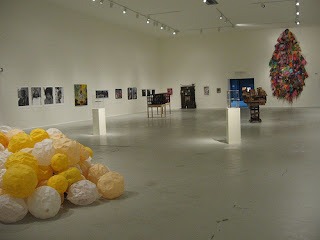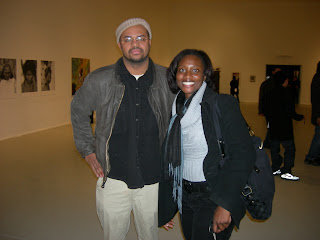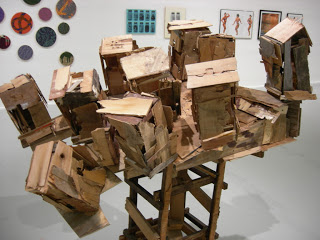
installation view of From Taboo to Icon: Africanist Turnabout at the Icebox Project Space, Crane Arts Building, photo Libby Rosof
I headed to the Crane Building Saturday primarily to see an exhibition with an intriguing title: From Taboo to Icon; Africanist Turnabout – the premise being that work either derived from or in response to African aesthetics is central to artists of the African diaspora and has been relatively excluded by mainstream (e.g. white) institutions. Organized under the auspices of Temple University by Sophie Sanders, a PhD student in art history, and artist Shervon Neckles, it filled two very large galleries with all the ambition of a museum exhibition and made me wonder why, among Philadelphia museums, only the Fabric Workshop and Museum (FWM) has a strong record of exhibiting art that addresses some of these concerns.
Polemical exhibitions are always a challenge – is the theme truly central to all the work, or is the art being used to explicate an idea? Libby will be reviewing the exhibition, and she and I concurred to a remarkable degree about the strongest work, but my Saturday visit gave me an unexpected chance to meet one of the curators and one of the artists.

Franky Laude Going Back Home 2007, various papers, photo Andrea Kirsh
The galleries were empty when I arrived, but after about fifteen minutes they filled with what appeared to be a group of serious high-school students who immediately began taking notes and photos. As I was inspecting the poetic floor-piece, a pile of irregular yellow and white globular forms titled Going Back Home, and wondering how its seeming abstraction related to the exhibition’s theme, a man approached and asked if I were with the group. No, I said, who was the group? It turned out they were students from New York in a program sponsored by the Joan Mitchell Foundation.

Franky Laude and Shervone Neckles in the exhibition From Taboo to Icon , photo Andrea Kirsh
And who was I talking to? Franky Laude, he said, the artist of the very work I was studying – so I told him I wanted to talk. Franky told me he’d moved to Philadelphia last year, following graduate school at Maryland Institute College of Art, and is working at the FWM. The piece was a reference to the calabashes of his native Haiti, which he remembered from his grandmother’s house. Calabashes are gourds grown for use as containers, eating utensils and musical instruments in the Carribean, West Africa and elsewhere. I know what calabashes are, I said, I’m from the tropics, too. Franky told me he constructed the work out of papier mache (formed over balloons) because he couldn’t obtain the actual gourds in Philadelphia.

We discussed the exhibition further and Franky told me about the work of another Carribean sculptor, Earl Fyffe of Jamica who, much to Laude’s amazement, arrived with only a bunch of wood and constructed Shanty entirely on site; much as the shacks of its subject are quickly assembled, I guess. Franky then introduced me to Shervone Neckles, one of the curators who had accompanied the students from New York. Shervone is a multi-media artist who received support from the Joan Mitchell Foundation and was teaching under its auspices (by the way, the Foundation has supported many artists with Philadelphia connections, including Mei-Ling Hom, Karen Kilimnick, Sarah McEaneany, Gabriel Martinez, Odili Donald Odita, Pepon Ossorio, Jody Pinto and Nami Yamamoto). Shervone and Sophie Sanders had been discussing the exhibition’s theme for a while. The exhibition also grew out of a series of three symposia at Temple that explored contemporary art from the perspective of African influences. It’s not a new subject, Shervone acknowledged (hardly; it was significant to artists since the 1920s and has been written about by scholars including Paul Gilroy, Robert Farris Thompson and Richard J. Powell). But that doesn’t make it any less current, as the varied and often provocative work in this exhibition attests.
From Taboo to Icon: Africanist Turnabout is on view Wed. – Sun., noon to 6, through Feb. 12. On Friday evening, Feb. 1 there will be a public reception with many of the artists in attendance and a group discussion at 7 pm. I plan to be there!









